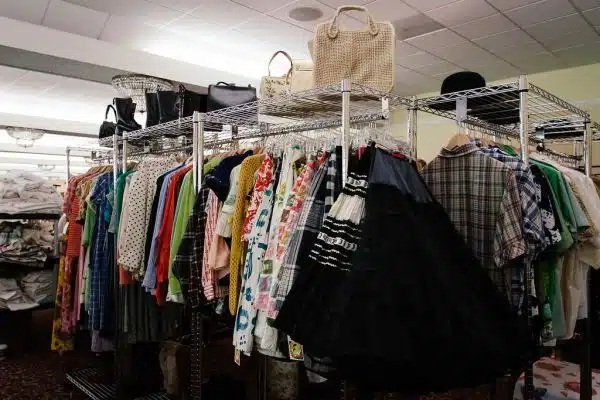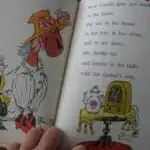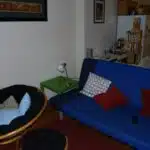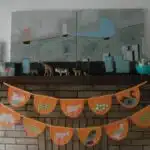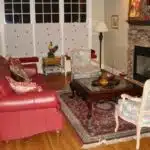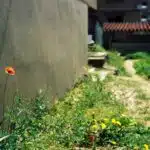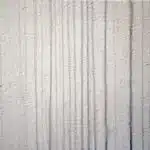Hanging vintage textiles on the walls is a unique way to add character and warmth to any interior space. Whether it be an antique quilt, a handwoven rug, or a collection of intricate tapestries, vintage textiles can transform a room with their rich colors, textures, and patterns. However, choosing the right textiles and properly displaying them can be a challenge for even the most experienced interior designers.
In this article, we will explore various techniques and considerations for hanging vintage textiles on walls. From selecting the right materials and hardware to creating cohesive arrangements that complement existing decor, we will provide practical tips and expert advice for showcasing these timeless pieces in your home or workspace. Whether you are looking to create a cozy bedroom retreat or an inviting living area for guests, our guide will help you elevate your interior design with the beauty of vintage textiles.
Understanding The Aesthetic Appeal Of Vintage Textiles
Exploring vintage textiles can bring a touch of history and individuality to your home décor. These fabrics are not only beautiful but also carry a sentimental value that adds character to any room. Decorating with vintage fabrics has become increasingly popular in recent years, as it allows us to incorporate unique pieces that tell a story.
One of the most significant aesthetic appeals of vintage textiles is their authenticity. The intricate patterns, colors, and textures reflect the craftsmanship of times gone by, adding a timeless quality to our interiors. Moreover, these textiles have a certain warmth and personality that cannot be replicated by modern fabrics. They create an inviting atmosphere that makes a space feel cozy and lived-in.
When it comes to decorating with vintage textiles, there are endless possibilities. From tapestries and quilts to rugs and curtains, these pieces can be incorporated into every room of the house. They add an element of surprise that draws the eye and creates interest in unexpected ways. Whether you choose to display them on walls or use them as accent pieces, vintage textiles have the power to transform any space into a unique work of art.
By understanding the aesthetic appeal of vintage textiles, you can begin choosing the right ones for your space. The next step is to consider factors such as color scheme, texture, and pattern when selecting pieces that will complement your existing décor. By taking these elements into account, you can create a cohesive look that showcases your collection while enhancing the overall ambiance of your home.
Choosing The Right Textiles For Your Space
Vintage textiles have the ability to transform a space, adding character and warmth to an otherwise dull room. Hanging vintage textiles on the walls is a great way to showcase their beauty while also making use of vertical space. When it comes to choosing which textiles to display, there are a few things to consider.
Firstly, it’s important to take into account the textile material. Some fabrics may be too delicate or heavy for wall hanging, while others may require special care or attention. It’s also important to think about color coordination – choose vintage textiles that complement your existing decor and add pops of color where needed.
One way to determine the placement of your textiles is by considering their size and shape. Smaller pieces can be grouped together in a gallery wall arrangement while larger pieces can be used as a focal point on their own. Don’t be afraid to mix and match different textures and patterns for added visual interest. With these tips in mind, you’ll be able to create a stunning display of vintage textiles that adds both style and personality to your living space.
Determining The Placement Of Your Textiles
Size is an important factor when determining the placement of textiles as it can affect the overall aesthetic of the space. The colors of the textiles should also be considered when determining placement, as it can create a unique visual impact. When placing vintage textiles on the walls, it is important to consider the aesthetic qualities of the room, such as the color palette, architectural features, and other decorative elements. Additionally, the size of the textile should be taken into consideration, as it can help create a balanced and cohesive look. Color is a significant factor when selecting a location for textiles, as it can create a unified and aesthetically pleasing atmosphere. Aesthetics should be considered when hanging vintage textiles, as the texture, pattern, and style can all contribute to the look of the space.
Size
When it comes to hanging vintage textiles on your walls, one of the most important things to consider is the size of the piece. Using different sizes can create a unique and creative display that adds visual interest to your space. One idea is to mix smaller pieces with larger ones. For example, you could hang a collection of smaller textiles together in a grid pattern, then add a larger piece above or below the grid to anchor it. This creates a sense of balance while still allowing each piece to shine.
Another creative display idea is to use textiles of varying sizes and shapes to create a gallery wall. This type of display works best when you have several pieces that are similar in style or color scheme. Begin by choosing one large statement piece as the focal point, then surround it with smaller pieces that complement its design. You can also mix in other types of artwork, such as photographs or paintings, for added visual interest.
Ultimately, determining the placement of your textiles comes down to personal preference and the specific needs of your space. However, by using different sizes and creative display ideas, you can showcase your vintage textiles in a way that highlights their unique beauty and adds character to any room in your home.
Color
Determining the placement of your textiles is an essential aspect of decorating your home. As an interior design expert, I highly recommend considering the color of your vintage textiles when deciding where to hang them. The color of a textile can greatly impact the mood of a room and can either complement or clash with other elements in the space.
When it comes to vintage textiles, you may find that they have a different color palette than modern textiles. Vintage textiles often feature muted or earthy tones, which can provide a warm and cozy feel to a room. However, if you are looking for a more vibrant and lively atmosphere, modern textiles with bold colors may be more suitable. It’s important to determine what mood you want to achieve in your space before selecting your textiles’ color scheme.
To create a cohesive look, consider using complementary color schemes when hanging your vintage textiles. For example, if you have a blue and white quilt, pairing it with navy or light blue accents will help enhance its beauty while creating visual balance in the room. Additionally, warmer colors like reds and yellows can add energy to a space, while cooler colors like greens and blues can create a calming effect.
In conclusion, understanding the impact of color on your vintage textile placement is crucial for achieving the desired mood in your home decor. By selecting complementary colors and considering the mood you want to achieve in each room, you can create beautiful displays that showcase both the unique beauty of each piece and your personal style as well.
Aesthetics
When it comes to determining the placement of your textiles, there are a few things to consider. Beyond just color, exploring textures and playing with layers can greatly enhance the aesthetics of your space. Mixing different textures like velvet and linen or layering a vintage rug over a modern one can create depth and interest in a room.
To truly achieve the desired aesthetic in your home decor, it’s important to consider the placement of your textiles in relation to other design elements. For example, hanging a vintage tapestry above a mid-century modern sofa may not be visually pleasing. Instead, pairing the tapestry with more traditional furnishings can create a cohesive look that highlights its unique beauty.
Overall, the key to successful textile placement is balance. By balancing different textures, colors, and styles in your space, you can create an aesthetically pleasing environment that showcases both your personal style and the unique beauty of each textile piece. So don’t be afraid to experiment and have fun with different placements until you find what works best for you and your space.
Preparing Your Textiles For Hanging
Before hanging your vintage textiles on the walls, it is important to make sure they are in good condition. This includes checking for any tears or stains that may need to be addressed before hanging. Additionally, it is important to prepare your textiles for hanging by utilizing proper ironing techniques and fabric care.
When ironing your textiles, always use a low heat setting and place a pressing cloth between the iron and the fabric to avoid burning or damaging the material. It is also important to avoid using starch or heavy-duty laundry detergents as these can weaken the fibers of your vintage textiles over time. Instead, opt for gentle cleaning solutions and consider hand-washing delicate pieces.
Fabric care is also crucial when preparing your vintage textiles for hanging. Always store them in a cool, dry place away from direct sunlight and avoid exposing them to excessive moisture or humidity. If you plan on framing your textiles, consider using archival materials that will protect them from fading or discoloration over time.
- Use a garment steamer instead of an iron if possible
- Consider professional cleaning services for especially delicate pieces
- Test any cleaning products on an inconspicuous area before applying to the entire textile
- Avoid folding or creasing your textiles as much as possible
Properly preparing your vintage textiles for hanging will help ensure their longevity and maintain their beauty for years to come. In the next section, we will discuss selecting the right hardware for your textiles to ensure they are safely and securely displayed on your walls.
Selecting The Right Hardware For Your Textiles
After preparing your textiles for hanging, the next step is to choose appropriate and secure hardware to avoid damage to the textiles during installation. It is important to consider the weight of the textile and the type of wall it will be hung on when selecting hardware. For lighter textiles, such as scarves or handkerchiefs, small picture hangers or adhesive hooks may be sufficient. However, heavier textiles, such as tapestries or quilts, will require more substantial hardware.
When choosing hardware for your vintage textiles, it is also important to consider the aesthetic appeal of the hardware itself. You may want to select hardware that complements the textile’s color scheme or design elements. Additionally, consider whether you want the hardware to be visible or hidden behind the textile.
Once you have selected appropriate hardware for your vintage textiles, take care during installation to avoid damaging the textile. Use a level and measuring tape to ensure accurate placement on the wall. Avoid hammering nails or screws directly through delicate areas of embroidery or appliqué by placing a protective layer between the textile and hardware. With careful consideration and attention to detail during installation, you can safely and beautifully display your vintage textiles on your walls.
To accurately place your textiles on the wall using chosen hardware requires precise measurements and markings before hanging them up. This involves taking into account factors such as height and spacing for optimal presentation in relation to other decor in your space. Inaccurate measurements could lead to an unbalanced look that detracts from your overall interior design scheme. Therefore, it is crucial that you measure and mark out your wall with precision before proceeding with hanging your vintage textiles up using secure hardware that has been carefully selected for this purpose.
Measuring And Marking Your Wall For Accurate Placement
Before hanging your vintage textiles, it is imperative to measure and mark your wall accurately. This will ensure that the textile displays evenly and at the desired height. Start by identifying the ideal location where you want to hang your vintage textile. Once identified, use a tape measure and pencil to mark the wall’s center point.
Next, measure the width of your textile display to determine its ideal placement on the wall. If you have multiple textiles that you want to hang together, consider creating a mock layout on the floor to determine their arrangement before hanging them on the wall. With this method, you can create a more cohesive look for your creative textile display ideas using alternative wall hanging methods.
When measuring and marking your walls for vintage textile displays, keep in mind that some textiles can be heavy and require additional support. In such cases, installing anchors and screws for heavy textiles is crucial for ensuring their safety and security on your walls. The following section will guide you through the steps involved in installing anchors and screws for heavy textiles with ease.
Installing Anchors And Screws For Heavy Textiles
When it comes to hanging heavy textiles on your walls, it’s crucial to utilize the right anchors and screws. For heavier items like tapestries or quilts, you’ll need to choose an anchor that can support the weight of your textile. There are several types of anchors to choose from, including toggle bolts, molly bolts, and plastic screw anchors.
Once you’ve selected the appropriate type of anchor for your textile, it’s important to place the screw in the proper location. In most cases, you’ll want to place the screw in a stud behind the drywall. This will provide maximum support for your textile and ensure that it stays securely in place. If you’re unable to locate a stud in the desired location, use a stud finder or consult with a professional before proceeding.
Proper screw placement is essential for ensuring that your textile hangs straight and doesn’t shift over time. Be sure to measure carefully and use a level to ensure that everything is lined up correctly before drilling any holes in your wall. With the right combination of anchors and screws, you’ll be able to hang even the heaviest vintage textiles without worrying about them falling down or causing damage to your walls.
When dealing with lightweight textiles such as scarves or handkerchiefs, tension rods can be an excellent option for hanging them on your walls. These rods are easy to install and won’t require any drilling or permanent alterations to your walls. In the next section, we’ll discuss how to properly install tension rods for lightweight textiles so that you can create a beautiful display without damaging your walls.
Utilizing Tension Rods For Lightweight Textiles
Tension rods offer a versatile and easy solution for displaying lightweight vintage textiles. These simple devices create a seamless, minimalist look that allows the beauty of the fabric to shine. With tension rods, you can create a unique gallery wall or showcase individual pieces in any room of your home.
To use tension rods for vintage textiles, first choose the perfect spot on your wall. Consider the size and shape of each piece to determine how many tension rods you will need. Once you have your placement decided, simply slide the rod through the top hem of your textile and adjust it to fit snugly in place. For extra security, you can add adhesive tabs to the back of your textile to keep it from slipping.
Here are four creative ways to display lightweight textiles using tension rods:
- Create a bold statement by layering multiple pieces on a single rod.
- Use varying lengths of rods to add depth and interest.
- Hang textiles at different heights for an asymmetrical look.
- Mix and match textures and patterns for an eclectic vibe.
With these tips in mind, you can easily incorporate vintage textiles into your home decor using tension rods. But why stop at one or two pieces? In our next section, we’ll explore how to create a stunning gallery wall with multiple vintage textiles that will truly transform any space.
Creating A Gallery Wall Of Vintage Textiles
When it comes to displaying vintage textiles on your walls, you can create a gallery wall that showcases your collection. One way to achieve this is by mixing textures and colors to create a visually appealing display. You can start by selecting a variety of fabrics, such as tapestries, quilts, and woven pieces.
To ensure that your gallery wall looks cohesive, you need to consider color coordination. You can select textiles that have complementary or analogous colors. Complementary colors are opposite each other on the color wheel, while analogous colors are next to each other. By using these color schemes, you can create a harmonious display that draws the eye.
Creating a gallery wall of vintage textiles is an excellent way to add character and warmth to any room in your home. By mixing textures and coordinating colors, you can create a visually appealing display that highlights your collection. In the next section, we will discuss how you can mix and match different textiles for a cohesive look without overwhelming your space.
Mixing And Matching Textiles For A Cohesive Look
When it comes to decorating your walls with vintage textiles, mixing textures and layering patterns are key to achieving a cohesive look. The juxtaposition of different materials such as cotton, linen, wool, and silk create visual interest and depth. Similarly, incorporating various patterns like stripes, florals, geometric shapes, and abstract designs can add dimensionality to your space.
To mix textures effectively, consider pairing rougher fabrics like burlap or canvas with smoother materials like satin or velvet. Combining these two contrasting textures creates a tactile experience that adds depth to the space. Additionally, layering different patterns can create an eye-catching display. Start with a larger scale pattern as your base and then add smaller prints on top. Remember to use colors that complement each other to avoid overwhelming the space.
Creating a harmonious blend of colors and patterns is essential when mixing and matching textiles in your home decor. Too much of one color can be monotonous while too many competing patterns can be chaotic. To balance colors and patterns for optimal effect, choose one dominant color as your base tone and then incorporate complementary hues in smaller accents throughout the room. Additionally, use larger patterned pieces sparingly while focusing on adding texture through solid colored fabrics. By thoughtfully combining textures and patterns with balanced colors in mind, you’ll create a visually stunning space that feels cohesive yet dynamic.
Transitioning into the subsequent section about balancing colors and patterns for optimal effect: Now that we’ve explored how to mix textures and layer patterns effectively, let’s take a closer look at how to balance colors for an even more striking display.
Balancing Colors And Patterns For Optimal Effect
When it comes to hanging vintage textiles on your walls, it is important to consider the balance of colors and patterns for optimal effect. One creative way to achieve this balance is by using vintage frames. Frames can add structure and definition to your hanging textiles, while also giving them a more polished look.
Another way to balance colors and patterns is by experimenting with different textile arrangements. You can try grouping textiles of similar colors together or mixing and matching contrasting patterns for a more eclectic look. Don’t be afraid to play around with different combinations until you find the perfect arrangement that works for your space.
Incorporating other decorative elements with your textiles can also enhance their overall impact on your walls. Consider adding mirrors, wall sconces, or even plants to complement your vintage textiles and create a cohesive design scheme. By taking the time to carefully balance colors and patterns, as well as incorporating other decorative elements, you can transform any room in your home into a stylish and visually appealing space.
Incorporating Other Decorative Elements With Your Textiles
As the saying goes, “less is more”. When it comes to incorporating other decorative elements with your vintage textiles, it’s important to remember that simplicity is key. One of the easiest ways to do this is by incorporating furniture into your space that complements your textiles rather than detracts from them. For example, if you have a beautiful vintage tapestry hanging on the wall, consider adding a simple wooden bench or chair underneath it to create a cozy reading nook.
Another way to incorporate other elements with your textiles is by adding lighting. Soft, ambient lighting can help highlight the beauty of your vintage pieces while also creating a warm and inviting atmosphere in your space. Consider adding table lamps or even string lights around the perimeter of the room to create a soft glow.
When incorporating other decorative elements with your vintage textiles, it’s crucial to remember that they should always be the star of the show. Avoid cluttering your space with too many accessories or decorative items that compete for attention. By keeping things simple and focused on your textiles, you can create a cohesive and visually stunning design scheme that celebrates their unique beauty.
In order to maintain the integrity of your vintage textiles over time, it’s important to take proper care of them. In the next section, we’ll explore some tips and tricks for cleaning and preserving these precious pieces so they can continue to be enjoyed for years to come.
Maintaining Your Vintage Textiles’ Integrity
- In order to preserve the colors of vintage fabrics, it is important to avoid direct sunlight and other sources of heat or humidity.
- Cleaning vintage fabrics should be done carefully and with the appropriate materials, such as mild soap and water, to avoid damage to the fabric.
- Storing vintage fabrics in a dark, dry place is recommended in order to prevent fading and discoloration.
- It is important to use the appropriate tools when hanging vintage fabrics in order to avoid causing any damage.
- Acid-free materials should be used to frame and mount vintage fabrics to protect their integrity.
- When moving or storing vintage fabrics, make sure to use acid-free tissue paper and enclose them in an airtight container for added protection.
Preserving Fabric Colors
Upon acquiring vintage textiles, it is essential to preserve their colors to maintain their integrity. Over time, fabrics tend to fade due to exposure to sunlight, moisture, and improper cleaning techniques. To avoid fading, it is advisable to limit the amount of direct sunlight that hits the fabric by hanging them away from windows or using UV protected glass for framing. This will help maintain the vibrancy of the colors and prevent them from becoming dull.
Proper cleaning techniques are also crucial in preserving vintage textiles’ colors. Harsh detergents and bleaches can cause discoloration and even damage the fabric’s fibers. It is best to use gentle cleaners specifically designed for delicate fabrics or seek professional cleaning services for valuable pieces. Additionally, avoiding excessive washing can prevent color loss over time.
In conclusion, maintaining the integrity of vintage textiles requires careful consideration of proper storage and handling techniques. Avoiding fading by limiting exposure to sunlight and employing gentle cleaning methods can help preserve these beautiful pieces for future generations to enjoy. By taking these precautions, one can ensure that their vintage textiles remain vibrant and continue telling their unique stories for years to come.
Cleaning Vintage Fabrics
When it comes to maintaining vintage textiles, there are several considerations to keep in mind. One of the most critical factors is ensuring that these fabrics are cleaned properly. Over time, vintage textiles can accumulate dirt and stains, which can cause discoloration and damage to the fibers. To prevent this, it is essential to use gentle washing techniques that do not compromise the fabric’s integrity.
Gentle washing is particularly crucial when dealing with delicate and valuable vintage fabrics. Using harsh detergents or bleaches can cause irreparable damage and result in color loss. Instead, it is best to opt for cleaners specifically designed for delicate fabrics or seek professional cleaning services for high-value pieces. Additionally, stain removal techniques should be approached with care and caution, as they can also cause discoloration if not done correctly.
To ensure that your vintage textiles remain in good condition for years to come, it is vital to take a proactive approach to their maintenance. This includes regular cleaning using gentle techniques, careful handling during storage and display, and prompt attention to any signs of wear or damage. By following these guidelines and taking care of your vintage textiles properly, you can preserve their beauty and history for generations to come.
Storing Safely
Proper storage is key to maintaining the integrity of vintage textiles. Preservation techniques are necessary to prevent damage and prolong the lifespan of these delicate fabrics. As an interior design expert, it is essential to be knowledgeable about the best practices for storing vintage textiles.
When it comes to storing vintage textiles, there are several factors to consider. Firstly, fabrics should be stored in a cool, dry place away from direct sunlight and moisture. Exposure to these elements can cause discoloration, fading, and mold growth. Secondly, it is advisable to store textiles flat or rolled rather than hanging them on hangers as this can cause stress on the fibers and lead to creasing or stretching. Lastly, it is important to avoid stacking multiple items on top of each other as this can result in crushing or uneven weight distribution.
Preservation techniques play a crucial role in keeping vintage textiles in good condition. Before storing fabrics, ensure that they are free from dirt and stains by using gentle cleaning methods. Avoid using harsh chemicals or detergents that may damage the fibers. Additionally, consider placing acid-free tissue paper between layers of fabric to prevent creasing and rubbing.
In conclusion, proper storage and preservation techniques are vital for maintaining the integrity of vintage textiles. As an interior design expert, it is our responsibility to educate ourselves on these best practices so that we can serve our clients better by preserving their valuable pieces for years to come. By following these guidelines, we can ensure that future generations will continue to appreciate the beauty and history of these unique fabrics.
Showcasing Your Personal Style With Vintage Textiles
Using vintage textiles as statement pieces is a great way to add character and warmth to any space. One of the most creative ways to showcase your personal style with vintage textiles is by repurposing them for wall decor. This not only provides a unique decorative element, but also preserves the life of the textile while giving it a new purpose.
When considering how to hang vintage textiles on the walls, it’s important to choose the right method. The best approach depends on the size, weight, and condition of the textile. For smaller and lighter pieces, consider using wooden dowels or curtain rods. For larger and heavier textiles, such as tapestries or quilts, use hanging sleeves or clips attached directly to the wall for added support.
Repurposing vintage textiles for wall decor allows you to enjoy their beauty and warmth in a new way. These statement pieces can be mixed and matched with other elements in your space such as furniture, lighting fixtures, and artwork to create an eclectic yet cohesive look. By incorporating these timeless pieces into your home design, you are not only preserving history but also adding a touch of individuality that reflects your personal style.
Enjoying The Beauty And Warmth Of Your Vintage Textile Wall Hangings
Maximizing impact when displaying your vintage textile wall hangings can bring a new level of beauty and warmth to any room. The first step in ensuring optimal display is selecting the right location for your piece. Consider the size and shape of the textile, as well as the surrounding decor and lighting. A large piece may be better suited for a focal point on an empty wall, while smaller pieces can be grouped together for a gallery-style display.
Another common mistake to avoid is improper hanging techniques. Avoid using adhesives or tape that can damage delicate textiles over time. Instead, use hooks or dowels that are appropriate for the weight and size of your piece. Be sure to also measure carefully before hanging to ensure proper placement and alignment.
Finally, don’t be afraid to get creative with your display! Consider incorporating complementary colors or textures in surrounding decor, such as throw pillows or rugs. You can also experiment with different arrangements or layering techniques to add dimension and visual interest. By following these tips and avoiding common mistakes, you can enjoy the full beauty and warmth of your vintage textile wall hangings for years to come.
Conclusion
Vintage textiles have a timeless appeal that can bring warmth and character to any space. By following the steps outlined in this article, you can create a stunning display of vintage textiles on your walls that will showcase your personal style and elevate the aesthetic of your space.
Choosing the right textiles for your space is key, as is determining their placement and preparing them for hanging. With careful attention to detail and an eye for design, you can create a cohesive display that incorporates other decorative elements and maintains the integrity of your vintage textiles.
Incorporating vintage textiles into your home decor is a beautiful way to add depth, texture, and personality to your space. By following these guidelines and allowing yourself to be creative, you can enjoy the beauty and warmth of these unique pieces for years to come. So don’t hesitate – start exploring the world of vintage textiles today!
Image Credits
- “Vintage Clothing & Textile Show” by Touch of Retro (featured)

